|
|
|
Sort Order |
|
|
|
Items / Page
|
|
|
|
|
|
|
| Srl | Item |
| 1 |
ID:
126411
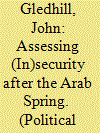

|
|
|
|
|
| Publication |
2013.
|
| Summary/Abstract |
More than two years after the heady days of protest and uprising that characterized the Arab Spring, the glow of revolution has given way to the intricacies and complications of regime building. Coalitions are being formed, constitutions written, judiciaries vetted, and security services (re)built. As collective attention focuses on these complexities of regime restructuring, it is worth noting that a fundamental security paradox sits at the heart of transitions in the Middle East and North Africa. On one hand, individuals who hit the streets or battlefields in support of revolution in 2011 did so in the belief that a new form of government would improve their political, social, and economic security over the long term. On the other hand, subsequent (and ongoing) efforts to draft new rules of the political game have triggered internal conflicts and, on occasion, those conflicts have compromised citizens' physical security over the short term.
|
|
|
|
|
|
|
|
|
|
|
|
|
|
|
|
| 2 |
ID:
111586
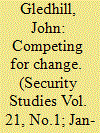

|
|
|
|
|
| Publication |
2012.
|
| Summary/Abstract |
When collective violence breaks out during periods of regime change, the root cause of that violence is ordinarily assumed to be a failure of state and/or governmental organizations, alongside transition. However, there are limits to the applicability of this understanding, since violence sometimes erupts during regime change, even when state and executive organs remain intact. This paper addresses those puzzling cases, by arguing that transitional violence can be a by-product of competition between, or within, a state's security services-for power and resources in an emerging regime. Competition develops where there is intense uncertainty about the form that the new regime might take and associated uncertainty about the distribution of power and state funds among state security services within that regime. The dynamics of transitional violence through intrastate competition are illustrated in the paper through treatment of two "most different" cases: Indonesia (1998) and Romania (1990).
|
|
|
|
|
|
|
|
|
|
|
|
|
|
|
|
| 3 |
ID:
133090
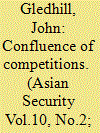

|
|
|
|
|
| Publication |
2014.
|
| Summary/Abstract |
In April 2006, riots broke out on the streets of Dili. As violence escalated over the weeks that followed, a beacon of liberal peace-building dissolved into near-anarchy. While there have been several accounts of Timor-Leste's "crisis" of 2006, it remains unclear why violence spiraled at that time, rather than at an earlier point in the country's post-conflict transition. This article addresses that temporal puzzle by combining an analysis of the structural origins of the crisis with discussion of proximate, agency-driven triggers to violence. The resulting narrative first details the development of competition between governing elites, and also between state security actors, over the years following independence. The fusion of those two dynamics of competition in 2006, I then argue, created conditions sufficient for violent conflict.
|
|
|
|
|
|
|
|
|
|
|
|
|
|
|
|
| 4 |
ID:
163327
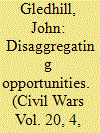

|
|
|
|
|
| Summary/Abstract |
In studies of armed conflict and civil war, it is common to distinguish between explanations that focus on the motives of insurgents and accounts that examine opportunities for rebellion. But what do scholars actually mean by ‘opportunities’? Some invoke the concept when referring to contexts in which states cannot suppress rebellion. For others, opportunities exist where insurgents have access to resources that facilitate the realisation of collective violence. And a third group refers to opportunities when discussing both of the above contexts. Across the field, then, the concept is used inconsistently. Consequently, I propose two conceptual clarifications. Drawing on insights from sociological literature, I argue that ‘opportunities’ should be disaggregated into two, more finite concepts: opportunity structures, understood as arrangements that inform externally imposed constraints on insurgency; and organisational resources, understood as means that shape the internal capacity of armed groups. Second, I suggest that conflict scholars should consider both material/institutional and social/normative dimensions of each disaggregated concept. To illustrate the heuristic benefits of the proposed framework, I use it as a basis for exploring variation in collective violence in Albania during the 1990s. That variation appears puzzling when seen through aggregated lenses but is explicable when examined through disaggregated lenses.
|
|
|
|
|
|
|
|
|
|
|
|
|
|
|
|
| 5 |
ID:
159416
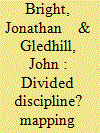

|
|
|
|
|
| Summary/Abstract |
Scholars in the field of peace and conflict studies have long worried that their discipline is divided – between studies of war and war making, and studies of peace and peacemaking. However, empirical research into the existence, extent, and nature of such a division is scarce. We remedy this by addressing two questions: 1) how is work in the field of peace and conflict studies distributed between its two nominal pillars: “peace” and (violent) “conflict”? and 2) to what extent is there communication and exchange between the two sets of studies? Making use of a unique combination of methods, we find that studies of violence hold a dominant position in the field, although there is also a sizable body of work that explores topics of peace, understood as conflict prevention and/or response. That said, we find limited evidence of intellectual exchange between studies of war/making and peace/making. We also find evidence of gendered, regional, and methodological divides. We argue that such schisms may be preventing scholars of peace and conflict from collectively realizing the founding ontological goal of their discipline, which was to understand the causes of war in order to contribute to an understanding of how conflict can be managed peacefully.
|
|
|
|
|
|
|
|
|
|
|
|
|
|
|
|
| 6 |
ID:
084369
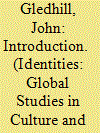

|
|
|
| 7 |
ID:
126416
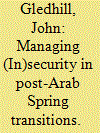

|
|
|
|
|
| Publication |
2013.
|
| Summary/Abstract |
The long-established authoritarian regimes in Libya, Yemen, and Egypt were very different in form. It is not surprising, therefore, that the way in which those regimes came to an end in 2011 varied significantly across cases. Nor is it surprising that the dynamics of transition in those cases have also varied since the Arab Spring. That said, the studies in this symposium have shown that, despite their many differences, processes of regime transition in Libya, Yemen, and Egypt have also shared two significant traits. First, disagreements among stakeholders over basic questions of institutional design have generated intense uncertainty about the nature of posttransition regimes. Second, political and military actors have occasionally turned to violence, in an effort to "resolve" their disagreements through force. In our symposium, we have tried to clarify the relationship between these shared traits of uncertainty and violence. To do this, we have disaggregated the concept of transitional uncertainty, considered the degree to which different forms of uncertainty have already fomented insecurity in post-Arab Spring states, and offered assessments of whether uncertainty may (continue to) prove destabilizing in those states going forward.
|
|
|
|
|
|
|
|
|
|
|
|
|
|
|
|
| 8 |
ID:
174088
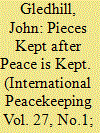

|
|
|
| 9 |
ID:
165322
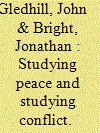

|
|
|
|
|
| Summary/Abstract |
“Peace” and (violent) “conflict” are often seen as conceptual mirror images of one another; peace is the absence of conflict, and conflict is the absence of peace. Given this conceptual interdependence, some scholars see that the study of war-making and the study of peacemaking are complementary—or even functionally identical—academic projects. Others, however, see that studies of violence and war-making are antithetic to studies of peace and peacemaking. The six contributions to this Journal of Global Security Studies forum explore these contrasting perspectives, with a view to assessing the “state of the discipline” of peace and conflict studies (and cognate disciplines, such as security studies). The introduction offers provocations for debate. The two contributions that follow consider connections and disconnections between the study of conflict and studies of postconflict peacebuilding and transitional justice, respectively. The next two contributions focus on areas of investigation that do not fit neatly into either the “peace” or “conflict” categories—gender and nonviolence—and the authors explore how studies of these topics might create bridges between scholarship on peace and studies of violent conflict. The concluding contribution argues that “mainstream” peace and conflict research has come to be dominated by positivist treatments of war and violence, and it draws attention to alternate approaches that have the potential to transform and ameliorate social relations.
|
|
|
|
|
|
|
|
|
|
|
|
|
|
|
|
| 10 |
ID:
108010
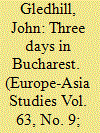

|
|
|
| 11 |
ID:
153502
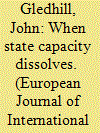

|
|
|
|
|
| Summary/Abstract |
When state capacity dissolves, we ordinarily assume that violent conflict will break out, and then spiral towards a high degree of intensity. However, this is not always the case. Rather, on occasion, states suffer a sharp and severe loss of capacity, but little or no collective violence follows. And, on other occasions, violent conflict erupts, but that conflict does not escalate into civil war; rather, it plateaus, and then recedes. This article offers an analytic framework for explaining such variation in the presence, absence, and intensity of violent conflict following a dissolution of state capacity. I argue that the strength of state and societal organs prior to a loss of state capacity shapes the broad trajectory of violence after such a loss. In making that claim, I associate three state-society dynamics before state dissolution with three levels of violent conflict, post-dissolution. Drawing on multi-country fieldwork, I illustrate the proposed framework by presenting three diverse cases of dissolving state capacity and conflict: Georgia (1991–3); Albania (1991–2); and Yemen (2011–13).
|
|
|
|
|
|
|
|
|
|
|
|
|
|
|
|
|
|
|
|
|